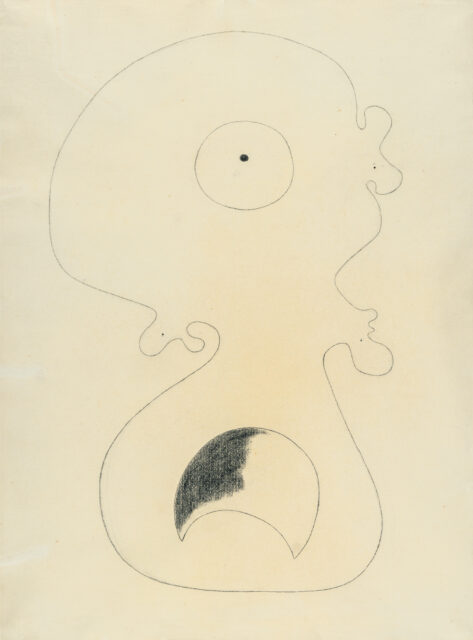Personnage au gros pied
Details
Dupin/Lelong-Mainaud I 334.With certificate of authenticity from Jacques Dupin, Paris, dated 2.3.1976.Exhibitions:Joan Miró, Galeria Theo, Madrid 1978;Joan Miró, Kunsthaus, Zurich/Kunsthalle, Düsseldorf 1986/87, cat. no.64, with ill. miró – obras de 1916 a 1976, Galeria Theo, Madrid 1990, cat. no.7, with ill.Joan Miró. La Naissance du monde 1917-1934, Centre Georges Pompidou, Paris 2004, cat. no.182, ill. p. 257.Provenance:Galería Theo, Madrid;Continental private collection.
Description
• Large, pure drawing in Miro’s typical formal vocabulary
• The motif was drawn as a small-format sketch during a summer spent in his home in Catalonia in Montroig
• Miro was able to overcome a creative crisis in around 1930 through a return to drawing
This wonderful, large-format drawing “Personnage au gros pied” is dated October 22, 1930 by Miró. It is based on a small sketch (22 x 15 cm), which was probably created during the previous summer months that the artist regularly spent in his Catalan home in Montroig. The exact same figure can be found in his sketchbook from this year, but the form-finding process with slight corrections can still be seen here (see Picon, Gaetan (ed.), Joan Miró: Carnets Catalans, Geneva 1976, vol. II, b/w fig. p. 89). In the large drawing, on the other hand, there is no longer any hesitation or searching in Miró’s line – the strange, childlike creature emerges in a single, confidently executed curve. The biomorphic body and in particular the one-eyed head refer to Miró’s figures from 1926, which can be found, for example, in the paintings “Person throwing a stone at a bird” (Museum of Modern Art, New York) and “Dog barking at the moon” (Philadelphia Museum of Art). After Miró’s surrealist phase in the mid-1920s, in which his famous works of image-poems and dream images were created, he reached an artistic crisis in 1929. He felt the need to break away from the lightness of his lyrical language, which threatened to become repetitive and sterile. Dupin puts it this way: “Miró had now reached absolute rock bottom. What brought him back to life was drawing. To get out of the impasse he found himself in, he had to make peace with his own winding lineage, so free and so skilled in every kind of magic. In the summer of 1930, in Montroig, he created a series of wonderful drawings, from which, in their spirit and with the impetus they gave him, he painted a final large canvas with a white ground, different in every respect from the previous ones.” (Jacques Dupin, Joan Miró. Life and Work, London 1962, p. 238).
* All results incl. buyer’s premium (27%) without VAT. No guarantee, subject to error.
** All post-auction prices excl. buyer's premium and VAT. No guarantee, subject to error.
*** Conditional Sale: The bid was accepted below the limit. Acquisition of the work may still be possible in our post-auction sale.
R = regular taxation
N = differential taxation on works of art which originate from a country outside of the EU
The private or commercial use of images shown on this Website, in particular through duplication or dissemination, is not permitted. All rights reserved.


